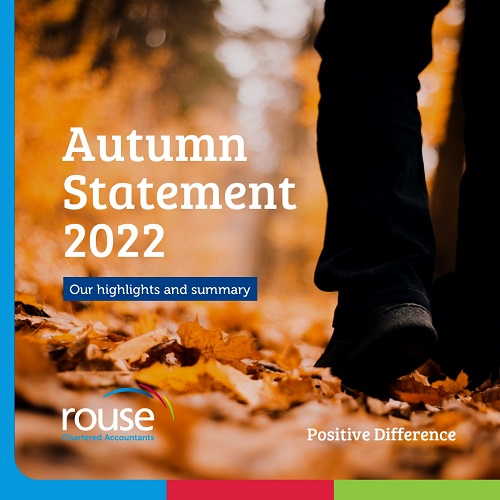Against a backdrop of weaker than expected economic growth, high inflation and a huge energy bill subsidy scheme that has burnt a £55bn hole in the public finances, the Autumn Statement was always expected to be an economic reality check.
The Chancellor pledged to restore public finances via two routes, half by tax hikes and half by spending cuts. And whilst much of what we heard had been widely speculated prior to the announcement, for many this will not make it any more palatable.
For individuals, the main theme was that those with more will pay more, but with the freezing of tax thresholds this means the burden will be felt by all taxpayers in the coming years as wage increases push people into higher tax thresholds. Some welcome news was that the energy support package will be extended after April 2023, albeit at a higher cap of £3,000 for most.
The dividend allowance being halved to £1,000 next year and again to £500 in 2024, will be a real blow to those running small businesses, some of whom will also be hit by the marginal increase in corporation tax, not to mention increased wage and energy costs. This may also change the picture for extracting earnings from businesses, and those taking dividends may want to revisit their salary/dividend split to ensure it is optimally balanced.
The changes to the R&D schemes were a story of two sides. We were disappointed to see the R&D tax credit for SME’s cut from 14.5% to 10%, which is a blow to a vital source of funding for many innovative start-ups and small businesses (in addition to the already announced tightening of the scheme eligibility). However, it was positive to hear that the Research and Development Expenditure Credit (RDEC) will rise from 13% to 20%. However, the RDEC doesn’t provide a cash repayment and so it is certainly not as valuable to innovative start-ups.
Those in retail and hospitality may be concerned about the impact that rising taxes and less disposable income has on their businesses this winter, at a time when they are still reeling from the pandemic and facing increased costs. On the flip side, the proposals on business rates, covering a freeze in the multiplier and extended reliefs, means those seeing their valuations decrease will see the benefit in their bills immediately, at the same time as increases are capped. It was also encouraging that the Chancellor confirmed that energy support will continue post-April for the most vulnerable sectors, of which hospitality has already been recognised.
All in all, the Autumn Statement was as billed – tax rises and spending cuts aimed at bringing the nation’s finances back in line. What we failed to hear from the Chancellor today was any real plan for economic growth, despite him recognising its importance. Perhaps once some stability is achieved, the focus will turn towards growth, but the outlook continues to remain uncertain.
Key highlights
For individuals
For businesses
Autumn Statement Summary Guide
You can download our full Autumn Statement Summary Guide here [4.88mb].

Oscar heads our tax department and provides advice on tax structuring, planning and compliance services to entrepreneurs and their businesses.



